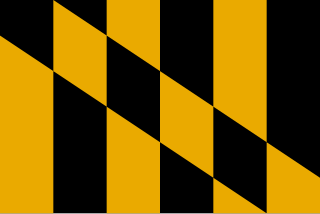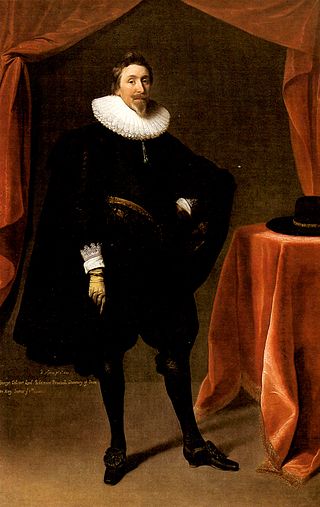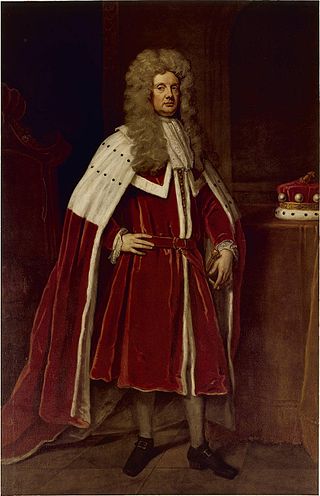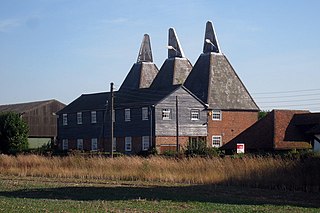
Cecil Calvert, 2nd Baron Baltimore was an English politician, peer and lawyer who was the first proprietor of Maryland. Born in Kent in 1605, he inherited the proprietorship after the death of his father, George Calvert, 1st Baron Baltimore, for whom it had been intended. Calvert proceeded to establish and manage the Province of Maryland as a proprietary colony for English Catholics from his English country house of Kiplin Hall in North Yorkshire.

The Province of Maryland was an English and later British colony in North America from 1634 until 1776, when the province was one of the Thirteen Colonies that joined in supporting the American Revolution against Great Britain. In 1781, Maryland was the 13th signatory to the Articles of Confederation. The province's first settlement and capital was in St. Mary's City, located at the southern end of St. Mary's County, a peninsula in the Chesapeake Bay bordered by four tidal rivers.

George Calvert, 1st Baron Baltimore was an English peer and politician. He achieved domestic political success as a member of parliament and later Secretary of State under King James I. He lost much of his political power after his support for a failed marriage alliance between Prince Charles and the Spanish House of Habsburg royal family. Rather than continue in politics, he resigned all of his political offices in 1625 except for his position on the Privy Council and declared his Catholicism publicly. He was created Baron Baltimore in the Peerage of Ireland upon his resignation. Baltimore Manor was located in County Longford, Ireland.

Charles Calvert, 3rd Baron Baltimore was an English peer and colonial administrator. He inherited the province of Maryland in 1675 upon the death of his father, Cecil Calvert, 2nd Baron Baltimore. He had been his father's Deputy Governor since 1661 when he arrived in the colony at the age of 24. However, Charles left Maryland for England in 1684 and would never return. The events following the Glorious Revolution in England in 1688 would cost Calvert his title to Maryland; in 1689 the royal charter to the colony was withdrawn, leading to direct rule by the British Crown. Calvert's political problems were largely caused by his Roman Catholic faith which was at odds with the established Church of England.

Benedict Leonard Calvert, 4th Baron Baltimore was an English peer and politician. He was the second son of Charles Calvert, 3rd Baron Baltimore (1637–1715) by Jane Lowe, and became his father's heir upon the death of his elder brother Cecil in 1681. The 3rd Lord Baltimore was a devout Roman Catholic, and had lost his title to the Province of Maryland shortly after the events of the Glorious Revolution in 1688, when the Protestant monarchs William III and Mary II acceded to the British throne. Benedict Calvert made strenuous attempts to have his family's title to Maryland restored by renouncing Roman Catholicism and joining the Church of England.

Leonard Calvert was the first proprietary governor of the Province of Maryland. He was the second son of The 1st Baron Baltimore (1579–1632), the first proprietor of Maryland. His younger brother Cecil (1605–1675), who inherited the colony and the title upon the death of their father George, April 15, 1632, appointed Leonard as governor of the Colony in his absence.

William Stone was an English-born merchant, planter and colonial administrator who served as the proprietary governor of Maryland from 1649 to 1655.
Richard Ingle was an English seaman, tobacco trader, privateer, and pirate in colonial Maryland. Along with another Protestant rebel, Captain William Claiborne, Ingle waged war against Lord Baltimore and Maryland Catholics in the name of English Parliament after his ship was seized and confiscated, siding with the Maryland Puritans in a period known as the "Plundering Time" during which unrest and lawlessness were widespread in the colony. Ingle and his men attacked ships and captured the colonial capital of the proprietary government in St. Mary's City, removing the Catholic Governor Lord Baltimore from power, in 1645. Most of Ingle's life and background are unknown.
Thomas Cornwallis was an English politician and colonial administrator. Cornwallis served as one of the first Commissioners of the Province of Maryland, and Captain of the colony's military during the early years of settlement. In a 1638 naval engagement with Virginian colonists, he captured Kent Island in Maryland.

Margaret Brent, was an English immigrant to the Colony of Maryland, settled in its new capitol, St. Mary's City, Maryland. She was the first woman in the English North American colonies to appear before a court of the common law. She was a significant founding settler in the early histories of the colonies of Maryland and Virginia. Leonard Calvert, Governor of the Maryland Colony, appointed her as the executrix of his estate in 1647, at a time of political turmoil and risk to the future of the settlement. She helped ensure soldiers were paid and given food to keep their loyalty to the colony, thereby very likely having saved the colony from violent mutiny, although her actions were taken negatively by the absentee colonial proprietor in England, Cecil Calvert, the second Lord Baltimore, and so ultimately she paid a great price for her efforts and was forced to leave the colony.
John Coode is best known for leading a rebellion that overthrew Maryland's colonial government in 1689. He participated in four separate uprisings and briefly served as Maryland's governor (1689–1691) as the 1st Leader of the Protestant Associators.

Andrew White, SJ was an English Jesuit Catholic missionary who was involved in the founding of the Maryland colony. A chronicler of Colonial Maryland, his writings remain a primary source on the land, the Native Americans and the Jesuit mission in North America.

Sheldwich is a village and civil parish in the far south of the Borough of Swale in Kent, England.
Thomas Notley was the 8th Proprietary Governor of Maryland from 1676 through 1679. Having first moved to Barbados he immigrated to America in 1662. He was the speaker of the legislature in 1666. He and fellow Barbadian immigrant Jesse Wharton passed slave codes similar to those in Barbados that punished those who helped in the escape of a slave or who stole and kept another planter’s slave for themselves.
William Joseph was the 11th Proprietary Governor of Maryland from 1688 to 1689. He was appointed by the colony's proprietor Charles Calvert, 3rd Baron Baltimore. Joseph attempted to maintain control of the colony in the proprietor's name, but religious turmoil related to the Glorious Revolution in England led to Joseph's being removed from office by Protestant colonists and the Calvert family losing control of the colony.
Sir Lionel Copley was the 1st Royal Governor of Maryland from 1692 through his death in 1693. He was the first official royal governor appointed by the British crown after the colony was removed from the proprietary control of the Calvert family during the Glorious Revolution. Copley engaged in a series of political struggles with the colonial assembly and the colonial secretary, Thomas Lawrence, in the year between his arrival and his death the next year.

The Battle of the Severn was a skirmish fought on March 25, 1655, on the Severn River at Horn Point, across Spa Creek from Annapolis, Maryland, in what at that time was referred to as the Puritan settlement of "Providence", and what is now the neighborhood of Eastport. It was an extension of the conflicts that formed the English Civil War, pitting the forces of Puritan settlers against forces aligned with Lord Baltimore, then Lord Proprietor of the colony of Maryland. It has been suggested by Radmila May that this was the "last battle of the English Civil War."

The situation of the Catholic Church in the Thirteen Colonies was characterized by an extensive religious persecution originating from Protestant sects, which would barely allow religious toleration to Catholics living on American territory. Nonetheless, Catholics were a part of colonial history from the beginning, especially in Maryland, a colony founded by Catholics, and Rhode Island, a colony founded explicitly for religious toleration. The situation was complicated greatly by the evolving role of the English Crown, which acted as both Supreme Governor of the Church of England and the Head of State of the thirteen colonial governments in almost all periods of colonial rule.

The Protestant Revolution, also known Coode's Rebellion after one of its leaders, John Coode, took place in the summer of 1689 in the English Province of Maryland when Protestants, by then a substantial majority in the colony, revolted against the proprietary government led by the Catholic Charles Calvert, 3rd Baron Baltimore.














